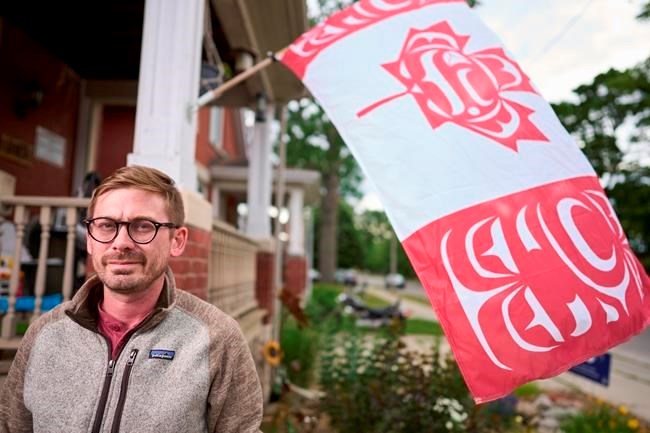OTTAWA — Puneet Luthra has always taken advantage of the Canadian flags his local MP's office gives away so he can raise one at his Toronto home.
“I just think it looks great. I think it’s beautiful,” he said.
But this year, he said, it feels different.
“The sad part is sometimes I wonder what people are going to think if I put the flag up,” said Luthra. “People could think that I'm someone with fringe ideas — like anti-vaxxers and things like that.”
The country is typically awash in red and white on the national holiday, but this year people across Canada are reflecting on their relationship with the Maple Leaf.
The "Freedom Convoy" demonstrations that gridlocked the streets of Ottawa in February may seem a long way off in the July sun, but the memory of protesters draped in flags, waving them while singing the national anthem and hanging them from the trucks whose horns blared day and night is still fresh for locals.
Ottawa is bracing for a new round of protests, with police saying this Canada Day will be "unprecedented and unique" with a never-before-seen security posture.
“People have made everyone confused about the value, the impact and the power of the Canadian flag and that's pretty sad,” Luthra said.
Blaine Schalk said he's felt a shift in his feelings about the flag's meaning since the convoy protests, during which flags were used for what he called "extreme patriotism." While dropping his son off at a recent birthday party, he saw a truck drive by with Canadian flags and convoy-related stickers.
“It's getting a connotation of: People who are the loudest are always the ones waving the flag,” said Schalk, who lives in London, Ont.
But Megan Ball Rigden said it's the country's own complicated colonial history that has her hesitant to embrace the red and white.
“I don't think I would be waving one myself regardless of the convoy, quite frankly,” she said.
Ball Rigden said people in her mom’s generation chose the Canadian flag, and it's close to their hearts for being representative of the “good things that we are.”
She said there's a front yard in her home city of Windsor, Ont., that is “red and white with hundreds of flags.”
“That person's doing it with nothing but love, but I understand it can certainly mean a lot more for a lot of people,” she said.
During the flag debate of 1964, the Maple Leaf was adopted as a kind of symbolic decolonization gesture with francophones in mind, to illustrate an equal partnership with English and French Canada, said Paul Litt, a history professor at Carleton University who studies Canadian nationalism and culture.
“The conservative reactionary forces were totally opposed to the Maple Leaf,” said Litt, adding they wanted to keep the Red Ensign as the nation’s flag for its symbolism of Canadian tradition and ties to Britain.
At that time, English and French Canadians were termed the “two founding peoples,” he said. “You don’t do that anymore.”
Almost 60 years on from that, people in Canada are starting to see their country and its founding in a different way.
“Time passing has really changed our perspective on ourselves,” said Ball Ridgen.
She feels the flag is representative of a political system that oversaw the colonization of Indigenous peoples, noting the discoveries of unmarked graves at residential schools throughout the country.
“I think people are realizing we've really done a good job at branding ourselves in Canada as being kind and loving all the time. But like anyone else, we've had our moments of being the oppressor,” she said.
It’s that reckoning with Canada’s past that led Schalk to buy a Canadian Indigenous flag last year, designed by Kwakwaka'wakw artist Curtis Wilson.
“I felt weird flying the Canadian flag after all those events,” Schalk said.
“I felt strongly that I’d rather fly that. I'm still proud to be Canadian, but I think that we've kind of left Indigenous Peoples by the wayside for a long time.”
“It’s not perfect … but might as well try.”
The Maple Leaf's current moment reflects a general problem with public discourse, Litt said, where there are “extremist” factions at both ends of the political spectrum.
While people on the right may seem to be appropriating the flag, as seen with convoy demonstrators, he said those on the left “set themselves up for it” by rejecting a lot of sacred national symbols.
“If they're going to be unpatriotic, then we'll be super patriotic,” Litt said of the right's thinking.
Canada's national identity has always been contentious, and people can identify strongly with the flag because they project themselves onto that imagined national community, Litt said.
“The reason they love the country so much is because they see the country as representing them,” he said.
“When you start to get these dramatic incidents where there's evidence that maybe Canada means something different than what you imagined it to be — an extension of yourself — that has great potential for dissonance.”
Ball Ridgen said she understands the flag can be a hurtful symbol for some, and a symbol to be proud of for others.
“Until as a country we analyze it together, I guess we need to have a little bit of ‘Canadian understanding’ for how we all see this,” she said.
“I think there is a space now for a bigger conversation. So in that respect, perhaps the convoy did something really good for all of us."
This report by The Canadian Press was first published June 30, 2022.
---
This story was produced with the financial assistance of the Meta and Canadian Press News Fellowship.
Erika Ibrahim, The Canadian Press
Note to readers: A previous version of this article misspelled Blaine Schalk's last name.



